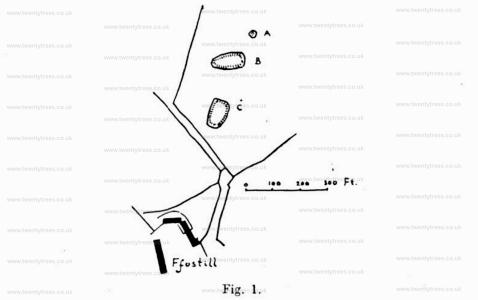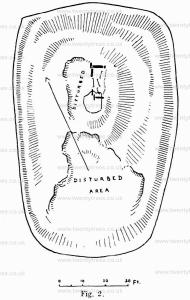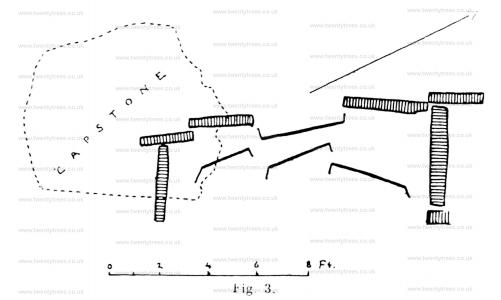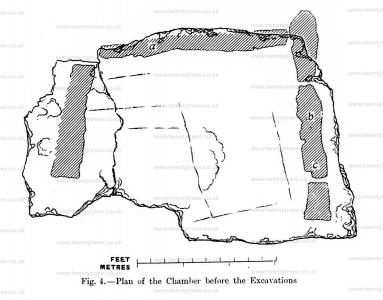Archaeologia Cambrensis Volume LXXVI 1921 Miscellania
Archaeologia Cambrensis Volume LXXVI 1921 Miscellania is in Archaeologia Cambrensis Volume LXXVI 1921.
Excavation Of A Long Barrow At Llanigon, Co. Brecon.— This Long Barrow [Map] is situated in the parish of Llanigon, on a spur of the Black Mountains, at about the 800 ft. contour line, and close to a track-way which once led from the direction of Abergavenny, and over the mountain to a ford below Llowes, and so into Radnorshire. It is unrecorded except for a reference to it as a "Druidical Altar" in the Transactions of the Woolhope Club for 1898.
When the writers commenced excavations on it in September, 1920, four stones protruded some 6 to 12 in. through the surface, and evidently formed a small cist. The elevation of the mound is slight, about 4 to 5 ft., and the ovoid-shaped outline measures roughly, 50 ft. long by 30 ft. wide. The barrow is aligned through its longest axis nearly due east and west, the narrow end pointing to the west.
Operations were commenced by carrying a trench from the west stone of the cist for about 14 ft. towards the apex. This disclosed nothing but a mass of shaley stones, many of considerable size, some being as much as 4 ft. in length, laid mostly horizontallv, and showed the barrow to be a true carnedd or cairn, was verified later by openings made in other parts of the mound.
The east and west stones of the cist had fallen over and were leaning in a westerly direction; the other two had gone over to the north. The interior of the cist was next cleared, and consisted of stones up to 2 ft. in length mixed with a certain amount of black earth, and intermingled throughout with bones in a fragmentary state. The west stone measured 5 ft. in height and ft. 6 in. in length, and overlapped the two adjoining stones, which measured about 5 ft. in height and G ft. in length. The east stone fitted inside the north and south stones, and was only 3 ft. in. in height and 2 ft. 6 in. in length. The internal measurement of the cist was 2 ft. 6 in. wide, 5 ft. 6 in. long, and 5 ft. high. All traces of the capstone had disappeared.
The bones were submitted to Prof. A. Keith, who reported that thev were those of Neolithic men, women, children, and a new-born infant. and that at least a dozen different individuals were represented. Only two of the bones showed signs of incineration, which possibly may have occurred through fires lighted on the surface of the mound, traces of which were observed. The tooth of a pig, bones of a dog, and of a small ox or pony were also found. Prof. Keith was of the opinion that senne of the bones might be later internments.
Several fragments of rough pottery were also found, and a few flint flakes, and later among the débris a number of blue beads. These latter were snlnnitted to Mr. Horace Beck, who in conjunction with Mr. Reginald Smith, of the British Museum, were of the opinion that they might be attributed to an Anglo-Saxon burial of the sixth century, A.D., and anyway, not earlier than the second century, A.D., thus confirming Prof. Keith's independent opinion that later burials had occurred in the cist. No metal or trace of any was found except a Roman coin of Crispus (A.D. 317—326), picked up an unauthorised searcher, but in what position is not known.
Trial holes were made in various parts of the mound to ascertain if there had ever been anything in the nature of a retaining wall, surrounding upright stones, or a ditch, but nothing of the sort was disclosed. A number of large upright slabs facing east and west were found on the north side of the axis at the narrow end of the mound, about 4 ft. apart, which appear to have only answered the purpose of strengthening the mound. Close to one of these slabs was found a small pocket of stones containing charcoal. Nothing in the nature of a passage-way or approach was discovered leading up to the cist.
W. E. T. Morgan,
Llanigon Vicarage.
George Marshall,
The Manor House, Breinton.
The Excavation Of A Megalithic Tomb [Map] In Breconshire by Colwyn Edward Vuilliamy (age 34).
v8KvnzVNThe farmstead of Ffostill is slightly over one and a half miles from the Breconshire border-village of Talgarth, in a north-easterly direction, and about the same distance from the foot of the northern escarpment of the Black Mountains. It is situated at the head of a gully which runs down from the foothills below the Range, and is on relatively high ground—just under the 1,000 ft. contour-line of the Ordnance Survey. Close to the farm buildings there is a most remarkable, if not unique, group of three tumuli. Fig. 1 will explain the placing of the tumuli [Ffostyll North Long Barrow [Map] and Ffostyll South Long Barrow [Map]] far better than a written description, and shows their peculiar arrangement. The axes of the two lower ones point respectively 21 degrees and 67 degrees east of true north. The mound which is marked "A" is a barrow of irregular shape (32 ft. by 29 ft.); while "B" and "C" are magnificent examples of the late Neolithic long barrow, of impressive size and massive construction.
Before proceeding with an account of the excavation of the long barrow "C," which is the main object of this paper, it will not be out of place to give a few particulars regarding the group.
The barrow "A," which bears external resemblance to the burial mounds of the Bronze Age, proved, on a pit being sunk therein, to contain characteristic relics of that period—namely, deposits of thick, unctuous charcoal; very small fragments of calcined bone, reduced in some cases to a white powder; and a few pieces of tiint, one of which was a triangular retouched flake. It had not been disturbed prior to my investigation, but the pit, sunk exactly In its centre, did not reveal any traces either of pottery or of a kist. The blocks of sandstone, of which it is constructed, have been placed with some regard for architectural method.
Colwyn Edward Vuilliamy: On 20 Jun 1886 he was born to Edwyn Papendiek Vulliamy and Edith Jane Beaven. On 04 Sep 1971 he died.

A casual glance at the two long barrows shows that they are of great importance to the archæologist. Their proximity to each other, their random orientation, their fine proportions, and the immense labour that must have been required to build them, are points that occur readily to the observant. Closer inspection reveals a disappointing fact: both have been rudely disturbed by persons who were impelled by other motives than those of scientific research.
In the case of "B," the kist or passage-chamber has been obviously rifled, and a great quantity of material shifted from its original position. Lacking information, one is inclined to regard this as the work of " treasure-hunters." At first glance, "C" appeared to have suffered a more searching devastation. Here I found that a vast amount of stone had been moved from the southern end, and there was considerable disturbance in the area which I expected to contain the principal kist. Furthermore, a large covering-stone lay tilted on the face of the mound.

On examination, I came to the conclusion that neither of these disturbances had touched the burial-chamber, which, though its form was not clear, was traceable in the centre of the highest part of the barrow. From information supplied by Mr. Gwillym, the tenant of the fartn, I learnt that stone had been removed from the lower end of the barrow about forty-five years ago, to supply material for road-making; and at that time quantities of human bones had come to light. I could find no account of the higher disturbance. Although it seerned clear that the principal part of the structure had been subjected to rude treatrnent, on the evidence of the displaced covering-stone, there was reason to believe that this had occurred at some rernote period, and that Inaterial of interest might still be found within the kist.

The plan of the barrow (rather suggestive of a stone celt in outline) is given in Fig. 2. It is 108 ft. long, and its greatest breadth is about 65 ft. The kist is roughly Il ft. by 4 ft.
Through the enthusiasm and initiative of my friend, Mr. A. F Gwynne of Glasbury, arrangements were made to excavate. the kist, and we began operations on September 20, 1921.
It should be explained, that this barrow, covered by a thin, wiry turf, through which stubborn bushes have thrust their roots, is built mainly of red sandstone, of which material it must contain several thousand tons. This is the stone of the district, found in abundance on the site.
The excavation of the kist occupied the bettor part of four days. I do not propose to do more here than summarise results, and it will be as well, first of all, to describe the character and construction of the kist, as revealed at the conclusion of our work.
Montelius's description of a "coffre de Pierre" (Reinach's translation) applies exactly to this instance. He says—" Un coffre de Pierre est un grand tombeau oblong quatre faces, træs analogue à la chambre d'une allée couverte . . mais sans couloir d'accès et ordmairement construit en grandes dalles." The plan (Fig. 3) and the section (Fig. 4) should be compared in order to realise the placing of the side-stones and terminals.
We found that the eastern side had collapsed inwards, in the manner shown—a fact which added very considerably to the diffculty of the excavation. Great care had to be taken in order to prevent further collapse, which, had it occurred, might have had distinctly unpleasant results. The side-stones, by no means of uniform dimensions, are massive slabs of red sandstone. They are well trimmed, and must have been set up with considerable engineering skill. Probably they were disturbed and damaged at the time of the displacement of the capstone. Their dimensions are, from 2 ft. 4 in. to 4 ft. 2 in. in breadth, from 5 ft. to ft. in depth, and from 4 in. to 8 in. in thickness. A comparatively small slab which we found tilted against the northern end of the chamber may have been part of an additional covering-stone, since the main capstone is not large enough to have roofed the entire kist. Below the thin covering of soil, the kist contained blocks and laminated fragments of sandstone—some of considerable size, but none too large to be lifted out by one man. These were so placed as to leave fairly large interstices between them. No earth or soil had reached the interior of the chamber.

We had not attained a depth of more than a foot when we found a layer of burnt bones, mostly in very small fragments, too small for exact identification, except in a few cases, but for the most part apparently not human, and probably representing the remains of goats, oxen, pigs, and other domesticated animals. There were a few pinches of charcoal in this stratum. At a depth of 2 ft. to 31 ft. (but not lower) we discovered human remains, in abundance, throughout the whole length of the chamber.
The bones were in the utmost confusion; only in a few instances were they in anatomical relation to each other, and by far the greater number were split and broken. Many of them were tightly wedged between the blocks of stone that filled the chamber. Some of the smaller ones—tarsal, metatarsal, phalanges, &c.—were complete, and I secured also a complete radius. The following is a summary of over 500 bones, teeth, and fragments which were removed and submitted to careful examination:
70 fragments of crania and lower jaws.
36 Inetacarpal, metatarsal and phalanges.
6 vertebrte.
30 detached teeth.
135 fragments of long bones, and certain coinplete bones.
240 miscellaneous fragrnents, including bones other than litilnan.
Of the human rernains, the rnost interesting are:- (1) the frontal bone and greater part of left parietal of a small adult skull, rernarkably dolichocephalic; (2) a male frontal bone, with strongly marked supra-orbital ridges; (3) other portions of skulls; (4) the greater part of a lower Jaw, with a cornplete set of incisors and second and third molars in position; (5) sundry less complete fragments of lower (6) several calcanea and astragali. jaws, with and without teeth; complete, or nearly so, and (7) the inferior extrenlity and greater part of a humerus, a cornplete radius, and the heads of two right femurs. It was found that the retnains were those of not fewer than nine individuals, of both sexes and various ages. I do not know how to account for (1) the absence of any fragrnent that could be definitely assigned to a pelvic bone; (2) the surprisingly small number of vertebra' discovered; (3) the fewness of carpal and metacarpal bones; and (4) the entire disappearance of the greater part of the skeletal remains, assuming that the bodies were buried intact. But it is probable that we are here dealing with an ossuary, in which only selections were deposited.
The best specimens were submitted to Sir Arthur Keith, and his report may be thus condensed:
The bones show the "dry eathy texture" and in some cases "the black metallic surface irnpregnation" which is characteristic of remains of ancient date. By an elaborate but reliable method of reconstruction, it was found that the cephalic index of the best preserved cranium was 70—the skull was nearly 22 mm. narrower than previously recorded Neolithic skulls from Wales. The individual had "a very narrow, relatively high, and rather small head." Presumably, the cranium is that of a man, about 40 years of age. Among the lower jaws was that of an old woman— must have had a face cast in a small, almost delicate mould." The (that part of the astragali show well-marked " squatting facets ankle-bone which is pressed upon by the tibia when the individual assumes the true squatting posture is definitely modified as a result of the habitual adoption of that posture). Although the principal remains were inhumations, untouched by fire, Sir Arthur has identified, from fragments, the cremated remains of a youth and of a very young child. In addition to the non-human species mentioned above, there were parts of the skull and jaws of a cat.

It is hardly necessary to state that, as is practically always the case with Neolithic burials, the persons with whom we are dealing were of small stature. I should estimate the height of the adult males at about 5 ft. 4 in.
No traces of pottery were discovered, but we found three pieces of flint within the kist, which do not call for special attention. One of them has been subjected to intense heat. Fragments of flint, and occasional implements, are scattered over the field in which the tumuli are situated, and over other fields in the vicinity.
Photographs of the bones, plans of the barrow and chamber, and an account of the excavation have been placed with the official records of the Ancient Monuments Board for Wales (H.M. Ofhce of Works). Typical specimens of the human remains were presented to the Royal College of Surgeons, and accepted by the President for the Museum of the College.
C. E. Vulliamy (age 34).
Glasbury House,
Glasbury, Hereford.